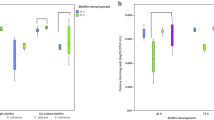Abstract
The adherence of Candida albicans and C. tropicalis to protein-adsorbed surfaces was investigated with surface-modified glass slides to which serum or salivary proteins were covalently bound. A specific adherence like a ligand-receptor interaction was observed between C. albicans and mucin- or salivary protein-immobilized glass slides. This interaction was eliminated by deglycosylation of the slides, suggesting that the receptor may be an oligosaccharide(s) contained mucin or saliva. A similar specific interaction was also observed between C. tropicalis and fibrinogen-immobilized glass surfaces. When the numbers of adherent cells to deglycosylated protein-immobilized glass glides were plotted against zeta potentials and contact angles of these protein-immobilized glass slides, a significant correaltion was observed between the numbers of adherent cells and zeta potentials in the case of C. albicans (r = −0.87), whereas a significant correlation was observed between cell numbers and contact angles (r = 0.82) in the case of C. tropicalis. These results suggest that the forces governing the adherence of fungi to pellicle in dentures may vary depending upon the surface properties of fungi and substrate.
Similar content being viewed by others
References
Budtz-Jørgensen E. The significance of Candida albicans in denture stomatitis. Scand. J. Dent. Res. 1974; 82: 151–190.
Douglas LJ. Adhesion of Candida species to epithelial surfaces. CRC Crit. Rev. Microbiol. 1987; 15: 27–43.
Rotrosen D, Calderone RA, Edwards JE. Jr. Adherence of Candida species to host tissues and plastic surfaces. Rev. Infect. Dis. 1983; 8: 73–85.
Klotz SA, Drutz DJ, Zajic JE. Factors governing adherence of Candida species to plastic surfaces. Infect. Immun. 1985; 50: 97–101.
Minagi S, Miyake Y, Inagaki K, Tsuru H, Suginaka H. Hydrophobic interaction in Candida albicans and Candida tropicalis adherence to various denture base resin materials. Infect. Immun. 1985; 47: 11–14.
Miyake Y, Fujita Y, Minagi S, Suginaka H. Surface hydrophobicity and adherence of Candida to acrylic surfaces. Microbios 1986; 46: 7–14.
Nikawa H, Sadamori S, Hamada T, Satou N, Okuda K. Non-specific adherence of Candida species to surfacemodified glass. J. Med. Vet. Mycol. 1989; 27: 269–271.
McCourtie J. & Douglas LJ. Relationship between cell surface composition, adherence, and virulence of Candida albicans. Infect. Immun. 1984: 45; 6–12.
McCourtie J, MacFarlane TW, Samaranayake LP. Effect of saliva and serum on the adherence of Candida species to chlorhexidine-treated denture acrylic. J. Med. Microbiol. 1986; 21: 209–213.
Samaranayake LP, McCourtie J, MacFarlane TW. Factors affecting the in-vitro adherence of Candida albicans to acrylic surfaces. Arch. oral Biol. 1980; 25: 611–615.
Odds FC. Candida and candidosis, 2nd edn. London: Bailliere & Tindall 1988: 252–278.
Jones GW, Isaacson RE. Proteinaceous bacterial adhesins and receptors. CRC Crit Rev Microbiol. 1983; 10: 229–260.
Nikawa H, Hamada T. Binding of salivary or serum proteins to Candida albicans in vitro. Arch oral Biol. 1990; 35: 571–573.
Weetall, HH. Covalent coupling methods for inorganic support materials. Meths. Enzymol. 1976; 44: 134–148.
Sojar HT & Bahl OP. Chemical deglycosilation of glycoproteins. Meths. Enzymol. 1987; 138: 341–350.
Critchley IA, Douglas LJ. Isolation and partial characterization of an adhesin from Candida albicans. J. Gen. Microbiol. 1987; 133: 629–636.
Critchley IA, Douglas LJ. Role of glycoside as epithelial cell receptors for Candida albicans. J Gen Microbiol 1987; 133: 637–643.
Douglas LJ, McCourtie J. Effect of tunicamycin treatment on the adherence of Candida albicans to human buccal epithelial cells. FEMS Microbiol Lett. 1983; 16: 199–202.
Kennedy MJ. Adhesion and association mechanisms of Candida albicans. Current Top Med Mycol. 1988; 2: 73–169.
Sandin RL, Rogers AL, Patterson RJ, Beneke ES. Evidence for mannose-mediated adherence of Candida albicans to human buccal cells in vitro. Infect. Immun. 1982; 35: 79–85.
Sobel JD, Myers PG, Kaye D, Levison ME. Adherence of Candida albicans to human vaginal and buccal epithelial cells. J Infect. Dis. 1981; 143: 76–82.
Bouali A, Robert R, Tronchin G, Senet GM. Binding of human fibrinogen to Candida albicans in vitro: a preliminary study. J Med Vet Mycol 1986; 24: 345–348.
Page S, Odds FC. Binding of plasma proteins to Candida species in vitro. J Gen Microbiol. 1988; 134: 2693–2702.
Author information
Authors and Affiliations
Rights and permissions
About this article
Cite this article
Nikawa, H., Sadamori, S., Hamada, T. et al. Factors involved in the adherence of Candida albicans and Candida tropicalis to protein-adsorbed surfaces. Mycopathologia 118, 139–145 (1992). https://doi.org/10.1007/BF00437146
Received:
Accepted:
Issue Date:
DOI: https://doi.org/10.1007/BF00437146




